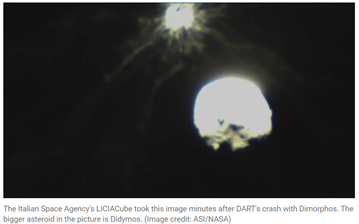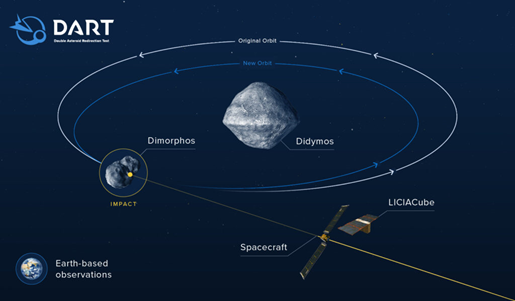

29th September 2022 (8 Topics)
Context
The Italian Space Agency has released images of the collision captured by its LICIACube a few minutes after the collision.
About
- LICIACube sent the images of NASA spacecraft-asteroid collision within minutes of the impact.
- Images such as these will be crucial in helping scientists understand the structure and composition of Dimorphos, which will be important to ascertain how effective DART was in diverting the asteroid.

About LICIACube:
- The LICIACube, also known as the Light Italian CubeSat for Imaging Asteroids, was launched from the Earth alongside the DART impactor.
- The CubeSat was given the important task of taking pictures prior to the collision and then flying away and taking pictures of the wreckage left behind.
- Role of LICIACube:
- The two cameras on CubeSat are capable of comprehensive images to provide NASA with the essential information regarding the crash.
- The cameras have been designed to take an image every six seconds till the impact. And afterward, during its flyby of the asteroid, LICIACube was tasked with taking three high-resolution images focusing on the asteroid, the impact and the debris left behind.
- Interestingly, during its flyby, the LICIACube was also entrusted to visit another side of the asteroid and take images, something the NASA DART Impactor was never able to see.
- The design of the LICIACube spacecraft is based on a 6U platform developed by the aerospace company Argotec in the framework of the ArgoMoon mission, adequately suited for the LICIACube mission, which will host two instruments:
- LEIA (LICIACube Explorer Imaging for Asteroid), a narrow field panchromatic camera to acquire images from long distance with a high spatial resolution.
- LUKE (LICIACube Unit Key Explorer), a wide field RGB camera, allowing a multicolor analysis of the asteroidal environment.
- Objectives of the LICIACube mission can be summarized as follows:
- to witness the DART impact on the Dimorphos surface;
- study the formation of the plume generated by the impact, in particular to characterize its structure and evolution, directly linked to the structure of the asteroid surface material;
- characterize – depending on the plume’s dissipation rate – the impact site on the Dimorphos surface, to obtain measures of the crater’s size and morphology;
- Observing the non-impacted hemisphere, to contribute to dimension and volume estimate of the target itself.

|
Double Asteroid Redirection Test (DART)
|
More Articles


